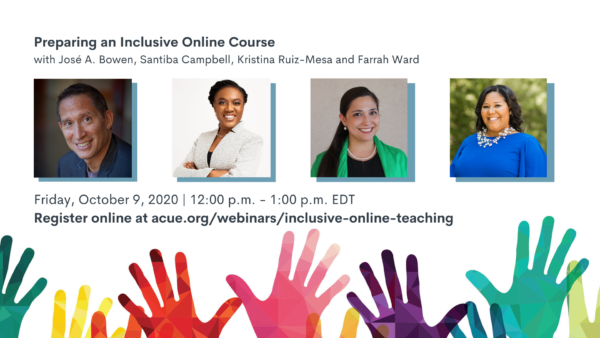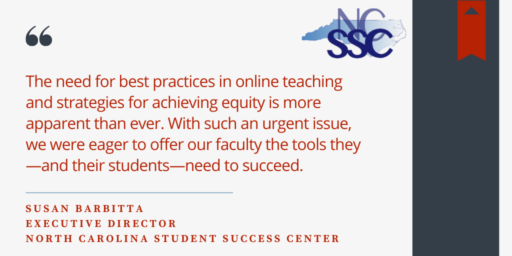
Preparing an Inclusive Online Course: Webinar Recap
“It’s even more important right now to ensure we’re creating courses that are inclusive,” Farrah Ward opined in the webinar Preparing an Inclusive Online Course, the second webinar in ACUE’s Inclusive Online Teaching webinar series, presented in collaboration with the American Association of State Colleges and Universities (AASCU), the American Council on Education (ACE), the Association of Public & Land-Grant Universities (APLU), The Council of Independent Colleges (CIC), Every Learner Everywhere (ELE), the National Association of System Heads (NASH), and Strong Start to Finish (SSTF).
Ward noted that students usually have a choice in what kinds of courses they take, but COVID-19 has taken that choice away, and students are coping with the myriad challenges of remote learning, such as having to share rooms and computers, facing food insecurity, and more.
“It’s essential for faculty to remain conscious that students are learning in different ways,” she said.
The discussion also featured insights from José Antonio Bowen, PhD, former president, Goucher College and author of Teaching Naked: How Moving Technology Out of Your College Classroom Will Improve Student Learning; Santiba Campbell, PhD, assistant professor, Department of Social and Behavioral Sciences, Bennett College; and Kristina Ruiz-Mesa, PhD, associate professor & basic course director, Department of Communication Studies, California State University, Los Angeles. Dr. Kevin Kelly, ACUE academic director, moderated the discussion.
Key Takeaways from the Conversation
Exercising empathy is crucial.
Displaying empathy was a theme of the webinar. Ward commented that faculty never truly know what students are going through — that there could be a reason why they don’t want to share their screen or don’t necessarily know how to use the technologies.
“How do we show students we care?” Ruiz-Mesa asked. She emphasized the importance of transparency — explaining the reasons behind actions, as well as being critically self-reflexive. “I think we have to allow ourselves the grace and flexibility we’re hoping for our students.”
Focus on language and communication.
“We have to ensure we’re communicating [our] ideas,” Campbell said. She encouraged faculty to focus on accessibility, considering how your assignments will be accessed. She also suggested being flexible in terms of engagement, perhaps, for example, offering office hours via phone, DMs, GroupMe, or text at different times to accommodate working students.
“Think about what to include in an e-communication policy,” Bowen suggested. “How fast do you respond to email? When do you respond? Do you use Google or Facebook chat?” He also advised revealing something about your own personal habits to students, such as when you check and respond to emails. “Students need more accessibility and want more security.”
“Students should feel and know that they belong in this course, on this campus,” Ruiz-Mesa added. “Are we taking time throughout the semester to remind students about the resources that are on campus and off?” Ruiz-Mesa, for example, adds resources like mental health organizations to her syllabus with statistics and data about who uses them to reduce stigma. “Think about language; how is it working toward the goal of equity and inclusion?”
Structure and flexibility go hand-in-hand.
“We’re trending toward a perfect storm,” Campbell said, pointing out that systemic racism, COVID-19, election season, and the upcoming holidays are colliding to put students and faculty in under an enormous amount of stress and fatigue. “We can’t bring our stress and fatigue into the classroom.” Structure and flexibility, she added, can help.
Bowen agreed, noting that these are both things students have requested, and they’re not actually contradictory. For instance, he said, it might be time to relax some restrictions while giving students a structure for how to study and complete their assignments, along with opportunities for reflection. “It’s the communication that I have high standards and I’m going to help you get there. That combination is really the secret sauce.”
“Think about course design,” Ruiz-Mesa added. “I think about what I want my students to walk away with and carry into their careers. How can I make this course different? How are students represented in the material?”
Ward said that faculty should focus on the learning objectives. “One thing I think we’ll learn from this phase is how to restructure our courses,” she noted. “Many of us have been in a groove.”
Consider how students can formulate their learning identity.
“A big component of online teaching is ensuring students have an identity,” Campbell said. She pointed to the ACUE welcome introduction, saying that faculty shouldn’t just introduce themselves but also have students do the same, an activity that allows them to establish their identity.
Faculty, too, need to speak to different identities, according to Bowen. Rather than encouraging everyone to apply for a specific scholarship or internship, for example, instructors should say something like “I would love to have a more diverse lab.” “Not everyone hears what you think is neutral as neutral,” he said.
“Identity is what brings us together,” Campbell added. She said that before broaching more sensitive topics like race and gender, faculty can “start small”—sharing zip codes, mascots, and so on. “Start with a shared, common identity — then build to others.”
Self-care is important for faculty, too.
“Model for students that we’re human,” Bowen said.
This, the presenters agreed, involves self-care. “If you take care of yourself, you will be improving your course,” Ward said. “Faculty should give grace to themselves. You cannot help anyone else unless you protect yourself first.”
“Let students know you’re tired,” Campbell agreed. “Use other resources to assist you. You can’t pour from an empty cup.”
Words of Wisdom
As the discussion wrapped up, the moderator invited each panelist to share a final thought on the topic:
“Be bold, be brave.” —Dr. Santiba Campbell
“Think about things you can that will help your most disadvantaged students. It doesn’t hurt anybody!” —Dr. José A. Bowen
“Clear, concise communication of care.” —Dr. Kristina Ruiz-Mesa

